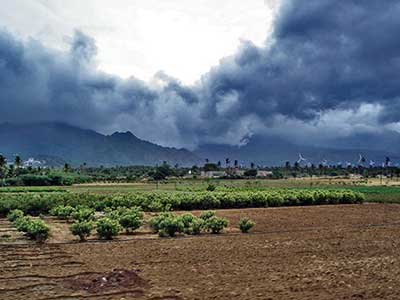Relevance: GS-3: Major crops-cropping patterns in various parts of the country, - different types of irrigation and irrigation systems storage, transport and marketing of agricultural produce and issues and related constraints; e-technology in the aid of farmers.
Key Phrases: La Nina, Neutral Indian Ocean Dipole, Inflationary Pressure, Complex Fertilisers, Economic Recovery, Cooling effect
Why in News?
- India Meteorological Department (IMD) has predicted a normal southwest monsoon
- Rainfall is expected to be 99 per cent of the historical average for the country during June-September.
- The prediction of a normal monsoon might bring some cooling effect in certain commodities, particularly domestically grown vegetable.
Basis for sanguine forecast:
- La Nina conditions
- La Nina conditions prevailing and likely to continue through the four-month monsoon season.
- Neutral Indian Ocean dipole
- Besides La Nina, which is generally favourable for the Indian monsoon, the IMD is counting on a “neutral” Indian Ocean Dipole (IOD).
- A “negative” IOD, wherein the eastern Indian Ocean waters off Indonesia and Australia turn unusually warm relative to the western part, is considered bad for the monsoon.
- The IMD believes that this time there will be La Nina and “neutral” IOD, at least till early in the season.
What is El Nino?
- An abnormal warming of the eastern Pacific waters usually causing heavy rains around South America, but also drought in the other western end whose effects percolate to India.
- It is the “warm phase” of a larger phenomenon called the El Nino-Southern Oscillation (ENSO).
What is La Nina?
- In the La Nina year, rainfall associated with the summer monsoon in Southeast Asia tends to be greater than normal, especially in northwest India and Bangladesh.
- It is the “cool phase” of ENSO, is a pattern that describes the unusual cooling of the tropical eastern Pacific.
- This generally benefits the Indian economy, which depends on the monsoon for agriculture and industry.
Reasons for Caution:
- Tight supply position of Plant nutrients:
- That hope — of a fourth consecutive normal monsoon — is somewhat negated when it comes to plant nutrients.
- India is today facing a tight supply position, especially in phosphatic and potassic fertilisers, ahead of the kharif sowings that will start with the monsoon.
- Global price rise of fertilisers:
- The country imports its entire muriate of potash (MOP) requirements. While it does manufacture phosphatic and complex fertilisers
- Their raw materials and intermediates — mainly rock phosphate, sulphur, phosphoric acid, and ammonia are largely imported.
- In the last one year, global prices of finished fertilisers and ingredients have doubled or trebled.
- War in Ukraine:
- Russia was the world’s largest and its next-door ally Belarus, the sixth largest fertiliser exporter in 2020 — has only worsened things and will continue to cause inflationary pressure.
- Hardly any new imports have been contracted in the past two months, with companies unsure whether the government will allow them to pass on the higher prices or absorb the burden through increased subsidy rates.
- Shift in labour availability:
- With contact-intensive jobs reviving in urban areas, a shift in labour availability may constrain acreage for the kharif season.
What should the government do?
- Announcement of higher subsidy to ensure adequate availability of nutrients.
- Promotion of Complex Fertilisers:
- It should immediately launch a campaign to promote single super phosphate and complex fertilisers like 20:20:0:13 and 10:26:26.
- These contain less phosphorus or potash than di-ammonium phosphate and MOP, but farmers can be shown ways to apply them in the right dosage (along with farmyard manure, compost, and organic wastes) without sacrificing crop yields.
- Use of high-analysis fertilisers is a luxury for a country with hardly any natural gas, rock phosphate, potash, or elemental sulphur reserves.
- Contract for more supplies:
- The government should also actively engage with countries such as Canada, Jordan, Morocco, Tunisia, Egypt, Senegal, Togo, even Russia and Belarus, to contract more supplies, both for kharif and the next rabi season.
Conclusion:
- There is room for optimism, as along with giving a boost to kharif crop production, the normal monsoon would brighten India’s prospects in agricultural commodities exports.
- But an increase in production doesn’t necessarily result in higher income for farmers, given India’s complex agriculture marketing system.
- Also, the implementation of the government’s support price mechanism is uneven across regions and crops.
- A good Southwest Monsoon when supplemented with adequate supportive measures and policies of government can help to boost agriculture production, which in turn should ease some of the inflationary concerns in the months to come while aiding the overall economic recovery.
Source: Indian Express
Mains Question:
Q. Good Southwest Monsoon is expected to boost agriculture production, which in turn would ease some of the inflationary concerns while aiding the overall economic recovery. State the reasons for higher monsoonal rainfall this year. Also explain the challenges associated with increased agricultural production despite increased rainfall. (250 words).








